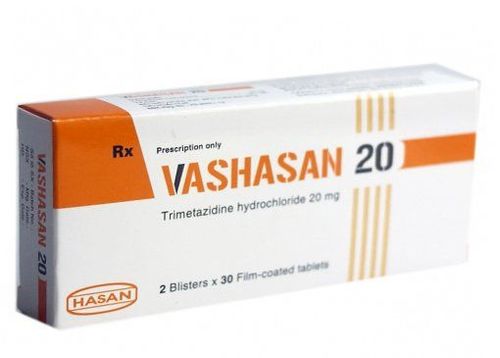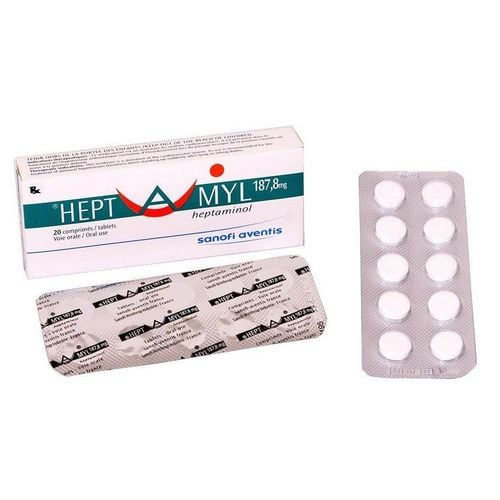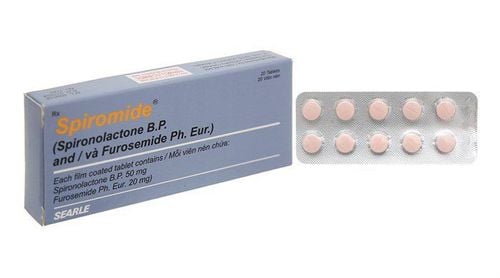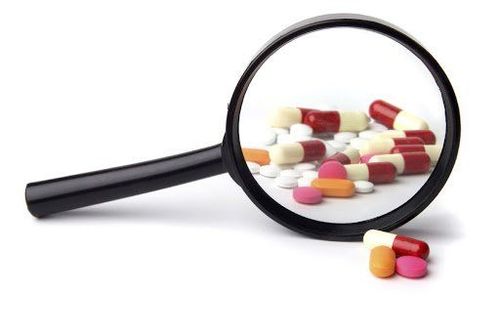This is an automatically translated article.
Vashasan contains the main active ingredient trimetazidin, which is able to maintain the energy metabolism of cells with hypoxia or ischemia, and prevent the decrease of intracellular ATP. Therefore, it is indicated as adjunctive therapy in stable angina.1. What is Vashasan?
Vashasan medicine contains the main ingredient is trimetazidine with many different strengths such as 20mg, 35mg. In particular, vashasan MR 35mg is a long-acting film-coated tablet. The mechanism of action of trimetazidine is to inhibit the oxidation of fatty acids by inhibiting the long-chain enzyme 3-ketoacyl-CoA thiolase, which is the enzyme responsible for the terminal phase of fatty acyl oxidation beta. thereby, trimetazidine will create an energy shift to perform glycolysis, thereby maintaining energy production while saving oxygen for the cells. The promotion of glucose oxidation will help optimize cellular energy processes, thereby maintaining proper energy metabolism during periods of anemia. In patients with myocardial ischemia, trimetazidine acts as a metabolite, helps to preserve energy levels in cardiomyocytes, can directly inhibit myocardial fibrosis and increase myocardial activity. pyruvate dehydrogenase enzyme. Trimetazidine is effective in preventing myocardial ischemia but does not affect hemodynamics. In addition, trimetazidine can also be used in the ear - nose - throat to support the symptomatic treatment of vertigo in meniere's disease and vascular vertigo because trimetazidine has the ability to improve vestibular tests. Trimetazidine is very rapidly absorbed after oral administration and reaches peak plasma concentrations 2 hours after oral administration. Equilibrium concentrations are reached between 24 and 36 hours after a repeated dose and are very stable during treatment. Trimetazidine has a half-life of 6 hours. The drug is excreted mainly in the urine as unchanged drug.
2. What is the indication of vashasan?
Vashasan 20 is indicated in adult patients as an adjunct/adjunct to existing therapy for the symptomatic treatment of patients with stable angina whose symptoms are inadequately controlled. or intolerance to other antianginal drugs.

Thuốc Vashasan 20 được dùng ở bệnh nhân đau thắt ngực ổn định
3. Dosage of the drug Vashasan
For vashasan 20mg, the usual dose is 1 tablet of 20mg x 3 times/day. If long-acting tablets are used, the recommended dose is usually one 35mg tablet twice daily. If patients with moderate renal impairment (creatinine clearance 30 - 60 ml/min): The recommended dose is 1 tablet of 20 mg/time x 2 times/day in the morning and evening, with meals. For extended-release tablets, it is 36mg x 1 time/day. For elderly patients: Elderly patients may have a higher than normal level of trimetazidine sensitivity. Therefore, care should be taken when calculating the dose for elderly patients. Children: The safety and effectiveness of trimetazidine in children younger than 18 years of age have not been fully evaluated. There are currently not many data on the use of trimetazidine in pediatric patients. Therefore, do not arbitrarily administer the drug to children.
4. What are the contraindications of Vashasan?
Vashasan is contraindicated in the following cases:
Hypersensitivity to Trimetazidine or any of its ingredients. Parkinson's patients, with Parkinson's symptoms such as tremor, restless legs syndrome and other movement disorders. Patients with severe renal impairment (with creatinine clearance less than 30ml/min).
5. Side effects of Vashasan
When using Vashasan, patients may experience unwanted effects including:
Common: headache, dizziness, abdominal pain, flatulence, nausea and vomiting, indigestion, urticaria, rash , asthenia . Rare: Palpitations, palpitations, tachycardia, flushing, orthostatic hypotension which may lead to malaise, dizziness or falls, especially in patients treated with other antihypertensive agents . In addition, Parkinson's symptoms (tremor, bradykinesia, increased muscle tone), unsteadiness, restless legs syndrome may be experienced. These symptoms are usually reversible upon discontinuation of the drug. Other side effects: sleep disturbances (drowsiness, insomnia), constipation, angioedema, agranulocytosis, thrombocytopenia, hepatitis. If you experience unwanted effects of the drug, you should notify your doctor for timely drug adjustment.

Thuốc vashasan 20 có thể gây rối loạn giấc ngủ của người bệnh
6. What are the precautions when using Vashasan?
The drug is not used to treat angina or not used for the initial treatment of unstable angina, myocardial infarction. Hypersensitivity to trimetazidine may cause or worsen symptoms of Parkinson's disease (tremor, bradykinesia, hypertonia), therefore patients, especially elderly patients, should be monitored regularly. When experiencing movement disorders such as tremor, restless legs syndrome, unsteady gait, it is necessary to stop using Trimetazidine immediately. These symptoms are rare and are usually reversible upon discontinuation of the drug. Most patients recover about 4 months after stopping trimetazidine. If Parkinson's disease-like symptoms persist for more than 4 months after discontinuation of the drug, a neurologist should be consulted. Patients taking the drug may experience symptoms such as falls, unsteady gait, or hypotension, especially in patients taking antihypertensive drugs. Caution should be exercised when prescribing trimetazidine to highly sensitive patients: patients with moderate renal impairment, elderly patients. Use in pregnancy: The results of animal studies have not conclusively established whether trimetazidine is teratogenic. There is currently insufficient clinical evidence to exclude the risk of fetal malformations. Therefore, it is best for patients not to take trimetazidine during pregnancy. Use in lactation: There is currently no evidence of the presence of trimetazidine in breast milk, therefore it is best not to breastfeed during treatment Ability to drive and operate Using machines: Trimetazidine may cause symptoms including dizziness, drowsiness. Therefore, it may directly affect the patient's ability to drive and use machines while taking the drug. If you forget a dose, take it as soon as you remember. However, if it is almost time for the next dose to be remembered, skip the missed dose and continue taking it as scheduled. Do not take a double dose to make up for a missed dose. Drug Interactions: Not much is known about vashasan drug interactions. Trimetazidine is not an inducer or inhibitor of hepatic drug-metabolizing enzymes. Therefore, it is likely that Trimetazidine does not interact with many drugs metabolized in the liver. However, patients still need to be cautious when taking medication and should inform their doctor of all medications they are taking for appropriate advice. Storage: The drug should be stored in a dry place, below 30°C. Avoid direct light. In summary, given its ability to maintain hypoxic cellular energy metabolism and prevent ATP depletion, vashasan may be indicated as an adjunct therapy in patients with stable angina. inadequately controlled or intolerant to other therapeutic agents. Patients should not arbitrarily use vashasan but should consult a doctor or pharmacist before use.
Please dial HOTLINE for more information or register for an appointment HERE. Download MyVinmec app to make appointments faster and to manage your bookings easily.













